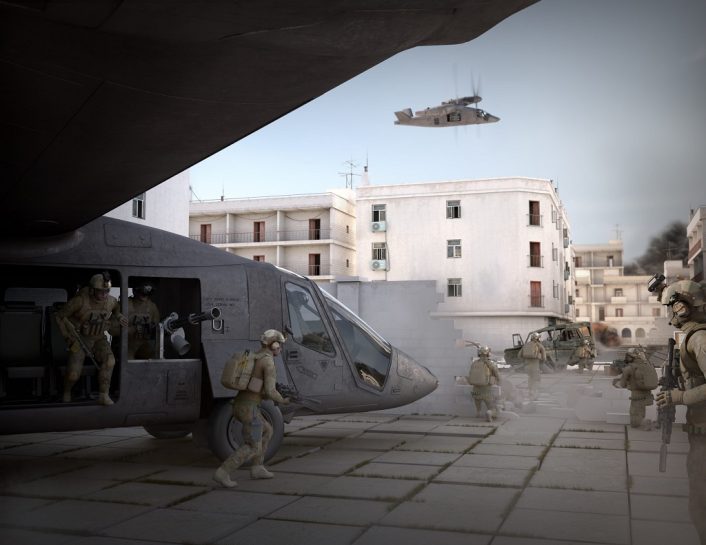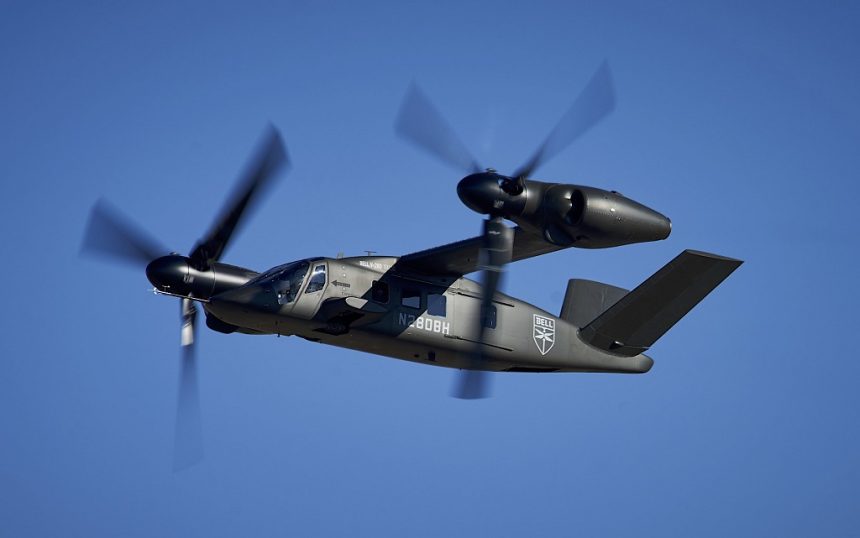Bell’s V-280 Valor tiltrotor won against Sikorsky’s Defiant compound helicopter and is set to become the new utility rotorcraft of the U.S. Army.
The U.S. Army has awarded the Future Long Range Assault Aircraft contract to Bell and its V-280 Valor tiltrotor. The announcement arrived on December 5, 2022 and represents the service’s largest helicopter procurement decision in 40 years. The Army initiated the FLRAA program in 2019 as part of its Future Vertical Lift initiative to replace a portion of its assault and utility helicopter fleet. The FLRAA is intended to eventually replace the UH-60 Black Hawk helicopter, which has been in service for more than four decades.
“This down-select represents a strategic pivot for Army Aviation to the transformational speed and range our Army needs to dominate future battlefields,” said Maj. Gen. Walter Rugen, director of the Future Vertical Lift Cross-Functional Team. “The prototyping and risk-reduction efforts allowed the Army to significantly reduce the time needed to get to today’s announcement.”
The FLRAA program will expand the depth of the battlefield by extending the reach of air assault missions and enabling ground forces to converge through decentralized operations at extended distances. The Army, in fact, required FLRAA to be capable, among all things, of traveling roughly 2,440 nautical miles without refueling, in addition to being agile enough to safely maneuver troops into dangerous hot spots.
The Army said it followed a deliberate and disciplined process in evaluating proposals to ensure rigorous review and equitable treatment of both competitors. During a media roundtable, officials said the decision was taken based on a “best value proposition.” after a comprehensive analysis of a variety of factors.
The Army also disclosed that, by implementing reform initiatives designed to streamline the acquisition process, this contract will deliver virtual prototypes that can be updated quickly and affordably. These virtual prototypes will directly support design, integration, training and developmental test activities, ahead of the delivery of the prototypes in the final configuration in 2025.
“This is an exciting time for the U.S. Army, Bell, and Team Valor as we modernize the Army’s aviation capabilities for decades to come,” said Mitch Snyder, president and CEO of Bell. “Bell has a long history supporting Army Aviation and we are ready to equip Soldiers with the speed and range they need to compete and win using the most mature, reliable, and affordable high-performance long-range assault weapon system in the world.”

The winning proposal, the V-280 Valor tiltrotor, was first developed and tested as part of the Joint Multi-Role Technology Demonstrator (JMR TD) program that began in 2013. The V-280 progressed through design, manufacturing, and more than three years of rigorous flight testing that provided extensive data validating the technical and operational advantages of the aircraft for the long-range assault mission.
Before Bell retired its flight demonstrator in June 2021, the V-280 flew more than 214 hours and demonstrated low-speed agility and long-range cruise capabilities, as well as a maximum 305-knot cruising speed. Five Army experimental test pilots have flown at the commands of the V-280 during 15 sorties, according to Bell, and their feedback, together with the ones from operational pilots, mechanics and infantry squads, was used to inform design plans.
“For the past several years the Bell team demonstrated the exceptional operational capabilities, digital thread synergies, and platform affordability enhancements the V-280 provides,” said Keith Flail, executive vice president, Advanced Vertical Lift Systems at Bell. “Bell stands ready with our world-class manufacturing facilities to apply our nearly seven decades of tiltrotor expertise to deliver a modern FLRAA fleet to the Army.”
The initial deal for the Army’s next-generation helicopter is worth up to $1.3 billion and is set, once the phisical rotorcraft’s procurement begings, to replace roughly 2,000 UH-60 Black Hawk utility helicopters. FLRAA, however, will not serve as a one-for-one replacement for the UH-60, but it’s intended to take over its roles around 2030.
The engineering and manufacturing development and low-rate production phases could be worth up to $7 billion. If then the full complement of required aircraft are purchased across the entire life of the fleet, the program could be worth up to $70 billion, according to Maj. Gen. Rob Barrie, the Army’s program executive officer for aviation.
“As the Army transforms to meet an uncertain future, FLRAA is one of the many modernized capabilities that will help ensure that the Army of 2030 is ready and able to win when the nation calls”, said the Army in the press release. In fact, the Future Vertical Lift program will also replace around 1,200 Apache attack helicopters through the Future Attack Reconnaissance Aircraft and Air-Launched Effects programs.
As we already reported, FLRAA saw the V-280 competing against the Defiant X. In a statement after the contract award to Bell, Sikorsky and Boeing said they “remain confident DEFIANT X is the transformational aircraft the U.S. Army requires to accomplish its complex missions today and well into the future. We will evaluate our next steps after reviewing feedback from the Army.”

Earlier this year, we took part to a media roundtable with Bell about their Future Vertical Lift effort. When we asked about the changes in doctrine required for the introduction of the tiltrotor, Bell’s officials told us that the Army doctrine established to counter current and future threats required new capabilities, which are speed, range and transformational capability. Operating further away and maintaining some distance from threats have been demonstrated in real world events to be among the most important capabilities right now.
Tiltrotor technology is considered a leap ahead in this sense and will give the Army relevance and opportunity especially over the long distances in the Pacific region. This will also enable the Army to make some sweeping doctrinal and tactics, techniques and procedures (TTP) changes over the course of the next decades, opening to new possibilities that were not considered before. Modernization is needed, in fact, in today’s environment and multidomain operations to gain a competitive advantage.
Bell’s officials also told us that work on the BA609 (now Leonardo AW609), along with the lessons learned from the XV-3, XV-15 and over 600k hours of operational experience from the V-22, played a significant role in the development of the V-280, contributing to the design and burning down a significant amount of risk.
Building on this experience, Bell pitched the V-280 as a third-generation tiltrotor, succeeding the second-generation Bell-Boeing V-22. A notable difference in the design of the two types is the V-280’s fixed engine nacelle, compared to the V-22’s nacelles which tilt along with its rotors. The company said this design will reduce manufacturing costs and provide better performance, maintainability and sustainability.
The aircraft is not being designed around a specific theater, according to the company, but it’s designed around reach, survivable range, speed and convergence of effects, allowing a force to get inside the decision cycle of an adversary in order to gain and maintain an overmatch over that adversary. That reach also gives the opportunity to put forces anywhere and anytime to deter adversaries.
Also, Bell says that Valor will be able to perform all the mission sets of the Black Hawk with the same footprint and the same infrastructure, including sling loading and urban operations. It is likely that, thanks also to the modular open systems approach, specialised variants will be developed as full-scale mockups have been displayed in various configurations, including as a pure assault platform, a weapons platform with roll-on/roll-off capability, and in a medevac configuration.









